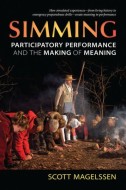Book Review: Simming: Participatory Performance and the Making of Meaning
Simming: Participatory Performance and the Making of Meaning
Scott Magelssen
Ann Arbor, MI: University of Michigan Press, 2014.
ISBN: 9780472072149
249 pp.
Few scholarly books open with as enticing a hook as Scott Magelssen’s excellent study of participatory performance, Simming. Magelssen seemed destined to write this book since his career as a simulator began in infancy when he subbed for an ersatz baby Jesus, stolen from a life-sized Christmas crèche in Wisconsin, to create, to the delight of on-lookers, a living nativity. He reprised his role as Christ, now as an adult, at Bible camps, and then went on to tackle multifarious role simulations as field research for this book, including a runaway African-American slave, illegal Mexican migrant, and the corpse of a Civil War soldier for a demonstration of embalming practices. That Magelssen not only immersed himself as a role-player in these simulated performances but also wrote about them with scholarly and artistic aplomb makes this book both good research and very good reading. It’s a rare work of scholarship that is also a page-turner. I couldn’t wait to see what outlandish situation he would get himself into next, and equally importantly, how he would contextualize these bizarre experiences within the frames of performance studies and U.S. cultural phenomena of the early twenty-first century.
Magelssen borrows the term “simming” from the online gaming universe, defined here as “deliberate, embodied practice” within “live, three-dimensional, immersive environments” where “spectator-participants engage in the intentionally simulated production of some aspect of real or imagined society, recognized as such by all parties” (5).
The book is organized into three broad sections that demonstrate how simming can be employed to explore past, present, and future situations, both real and imagined. Part one describes tourist simmings at locations such as Old Sturbridge Village in Massachusetts and Conner Prairie interactive history park in Indiana. Part two delves into learner-driven simming that helps participants bear witness to the present. The participants are given information, invited to role play, presented with dilemmas, and encouraged to make their own choices based on their recently acquired knowledge. This focus on deep learning and the agency afforded the actor-simulators is further expanded in part three, where engagement involves rehearsing for the future. In this section, Magelssen investigates real-life entities—schools, churches, the military—that employ simulations to prepare participants for life-and-death situations. These include bio-chemical attacks, mock drunk-driving car crashes, and war in Iraq and Afghanistan. In each scenario throughout the book, Magelssen tells a compelling story spun from personal involvement and observations, investigates the issues from a multitude of perspectives, and cites prominent theoretical scholarship that supports, critiques, or interrogates the work and its potential efficacy as a tool for learning and/or effective change.
What is most remarkable about this book is not so much its contribution to the growing field of performance studies—and certainly it has a proud place in that literature—but its penetrating study of early twenty-first-century American culture and politics. It is a must for serious graduate collections but is also a fascinating, accessible study for all readers.
Martha S. LoMonaco
Fairfield University

